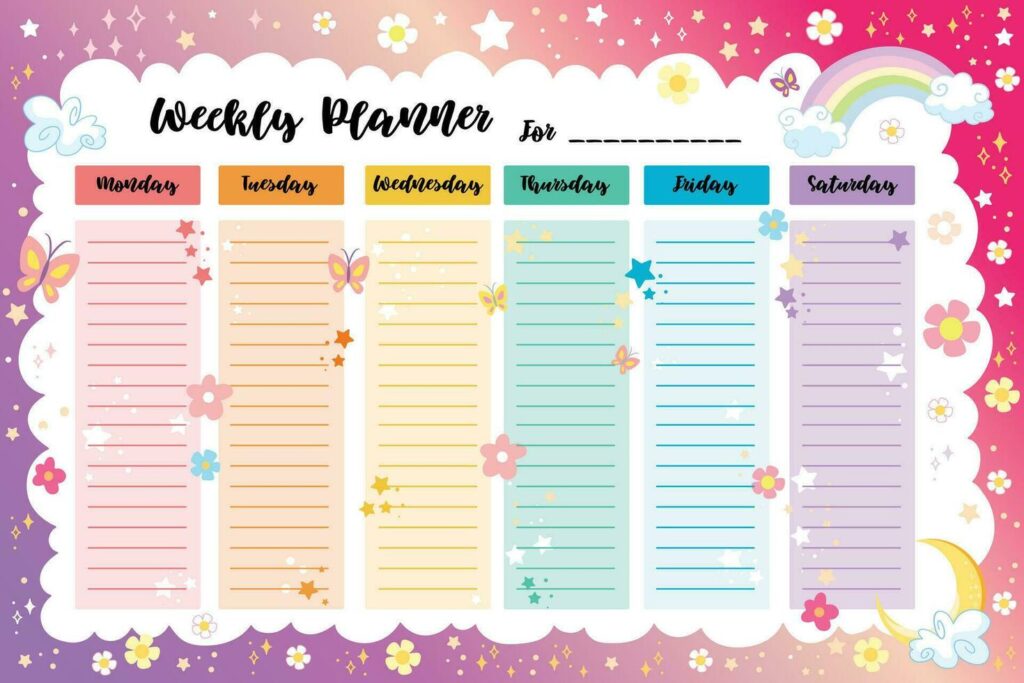In today’s fast-paced world, staying organized and managing your time effectively can make a big difference in achieving your goals. A weekly planner is a powerful tool that helps you stay on track, prioritize tasks, and maintain a clear overview of your commitments. Whether you’re balancing work, personal life, or both, using a weekly planner can dramatically enhance your productivity.
In this guide, we’ll explore practical tips on how to maximize productivity with a weekly planner, from setting achievable goals to managing your time efficiently. By incorporating these strategies, you’ll not only improve your focus but also reduce stress and ensure a balanced life.
1. Choose the Right Planner for Your Needs
The first step in maximizing productivity with a weekly planner is choosing the right type of planner for your lifestyle and preferences. Whether you prefer a digital planner or a physical one, select a layout that suits your planning style.
Types of Weekly Planners:
- Digital Planners: Apps like Google Calendar, Notion, or Todoist allow you to easily organize tasks, set reminders, and sync across devices. They’re ideal for people who prefer flexibility and accessibility on the go.
- Paper Planners: A classic paper planner provides a tactile experience and allows for personalized layouts. Many people find it satisfying to write things down, and it helps reinforce memory and commitment.
2. Set Clear and Achievable Goals for the Week
Setting specific, realistic goals is essential for making the most of your weekly planner. Start each week by identifying the major tasks or objectives you want to accomplish. Break down larger projects into smaller, actionable steps to avoid feeling overwhelmed.
SMART Goals:
Make sure your weekly goals are Specific, Measurable, Achievable, Relevant, and Time-bound. For example, instead of writing “Work on project,” write “Complete first draft of project proposal by Friday.”
3. Prioritize Your Tasks
A common mistake in planning is treating all tasks as equally important. Instead, prioritize tasks based on urgency and importance. This helps you stay focused on what truly matters and ensures you’re using your time efficiently.
The Eisenhower Matrix:
Use the Eisenhower Matrix to categorize tasks:
- Important and urgent: Do these first.
- Important but not urgent: Schedule time for these.
- Urgent but not important: Delegate if possible.
- Neither urgent nor important: Consider eliminating these.
By focusing on the most important tasks early in the week, you prevent them from becoming last-minute emergencies.
4. Time Block Your Week
Time blocking is a technique where you dedicate specific blocks of time for each task or group of tasks. It allows you to focus on one activity at a time, preventing distractions and increasing efficiency.
How to Time Block:
- At the start of the week, review your tasks and goals.
- Assign each task to a specific time block in your planner, ensuring you leave some buffer time between tasks.
- Stick to your schedule as much as possible, and adjust as needed if priorities shift during the week.
For instance, if you have a major presentation on Friday, you could time block an hour on Monday for research, another block on Wednesday for creating slides, and so on.
5. Track Your Progress Throughout the Week
Tracking progress keeps you accountable and ensures that you’re making headway on your goals. At the end of each day, review what you’ve accomplished and adjust the rest of your week accordingly.
Daily Check-Ins:
- Morning review: Look at your tasks for the day and identify the top three priorities.
- Evening reflection: Reflect on what you accomplished and whether adjustments are needed for the following days.
This routine helps you stay organized and ensures that you stay on top of your commitments, avoiding last-minute rushes.
6. Build Flexibility into Your Schedule
While planning is crucial for productivity, it’s equally important to stay flexible. Unexpected tasks or emergencies may arise, and rigid scheduling can lead to stress. Build in some open time or “buffer blocks” throughout your week to accommodate changes.
Handling Unplanned Tasks:
- Triage tasks: When something new comes up, evaluate its importance and urgency using the Eisenhower Matrix.
- Reschedule if needed: If a new task is urgent, consider rescheduling a lower-priority task to another day.
Flexibility ensures that you remain productive without feeling overwhelmed by changes in your schedule.
7. Use the Pomodoro Technique for Focus
The Pomodoro Technique is a time management method that helps you stay focused and avoid burnout. It involves working in short, timed intervals (usually 25 minutes), followed by a short break. After four intervals, take a longer break.
How to Incorporate Pomodoro in Your Weekly Planner:
- Schedule tasks in 25-minute blocks: For tasks that require deep focus, block off several Pomodoro sessions in your weekly planner.
- Take breaks: Use your breaks for short, refreshing activities like stretching or a brief walk to recharge your energy.
This technique keeps you focused and energized, preventing mental fatigue and increasing productivity throughout the week.
8. Review and Reflect at the End of the Week
At the end of each week, take time to review your progress. What did you accomplish? Were there tasks that didn’t get done? What can you improve next week?
Weekly Reflection Questions:
- What were my biggest achievements this week?
- Did I stay on track with my time blocks and priorities?
- What challenges did I face, and how can I address them moving forward?
By reflecting on your weekly performance, you can make necessary adjustments for the upcoming week, ensuring continuous improvement in your planning process.
9. Incorporate Self-Care and Downtime
Productivity isn’t just about work—it’s also about ensuring you have time for rest and self-care. Schedule downtime in your weekly planner for relaxation, hobbies, and exercise. This helps prevent burnout and keeps you motivated throughout the week.
Balancing Work and Life:
- Physical activity: Schedule workouts or walks to stay energized.
- Mindfulness: Dedicate time to meditation or journaling to clear your mind.
- Personal time: Plan time with family or friends to maintain a healthy work-life balance.
A well-rounded schedule ensures that your productivity is sustainable in the long run.
10. Keep Your Planner Simple and Consistent
The key to maximizing productivity with a weekly planner is consistency. Make your planning routine simple and straightforward so that it becomes an easy habit to maintain.
Avoid Overloading:
- Stick to a manageable number of tasks each day.
- Avoid filling every hour of your planner—leave space for flexibility and creativity.
Consistency is more important than complexity. The simpler your planning process, the more likely you’ll stick with it, allowing you to maximize productivity week after week.
Conclusion
Maximizing productivity with a weekly planner is all about staying organized, prioritizing your tasks, and maintaining a balance between work and rest. By choosing the right planner, setting clear goals, time-blocking your schedule, and staying flexible, you can significantly boost your efficiency and reduce stress. Whether you’re managing a busy career, personal life, or a combination of both, these strategies will help you make the most of your time, leading to a more productive and fulfilling week.
FAQs
1. What’s the best way to prioritize tasks in a weekly planner?
Use the Eisenhower Matrix to categorize tasks by importance and urgency. Focus on completing important and urgent tasks first, while scheduling time for non-urgent but important ones.
2. How often should I review my weekly planner?
It’s ideal to review your planner daily, checking tasks in the morning and reflecting on progress in the evening. At the end of the week, perform a more in-depth review to adjust for the upcoming week.
3. How can I stay motivated using a weekly planner?
Setting clear, achievable goals and tracking your progress can help keep you motivated. Celebrate small wins and adjust tasks to avoid feeling overwhelmed.
4. What’s the advantage of time blocking?
Time blocking helps you focus on one task at a time, preventing distractions and ensuring that important work gets done. It also provides a clear structure for your day.
5. How do I handle unplanned tasks or changes in my schedule?
Build flexibility into your schedule with buffer time, and reschedule less urgent tasks if necessary. Stay adaptable by reevaluating priorities when new tasks arise.
6. What tools can I use for digital weekly planning?
Popular digital tools include Google Calendar, Todoist, Notion, and Microsoft Outlook. These allow you to set reminders, organize tasks, and sync your schedule across devices.







